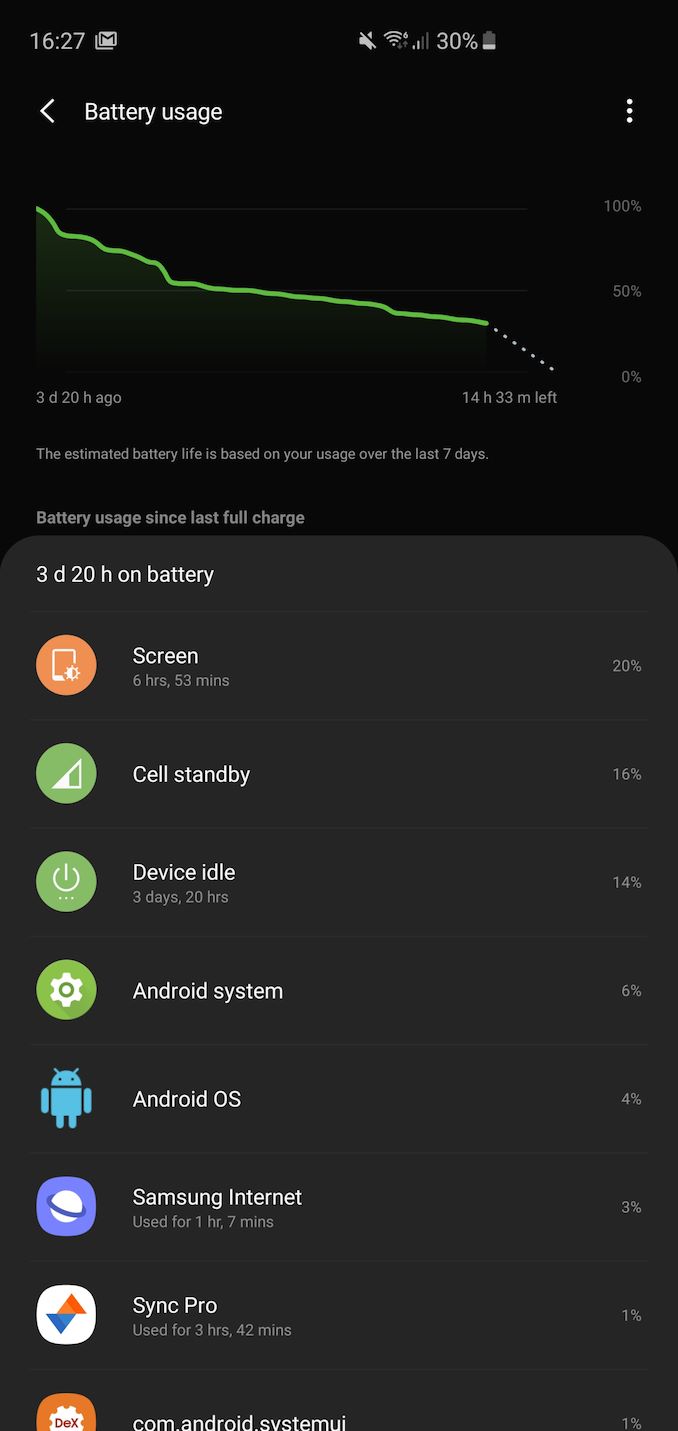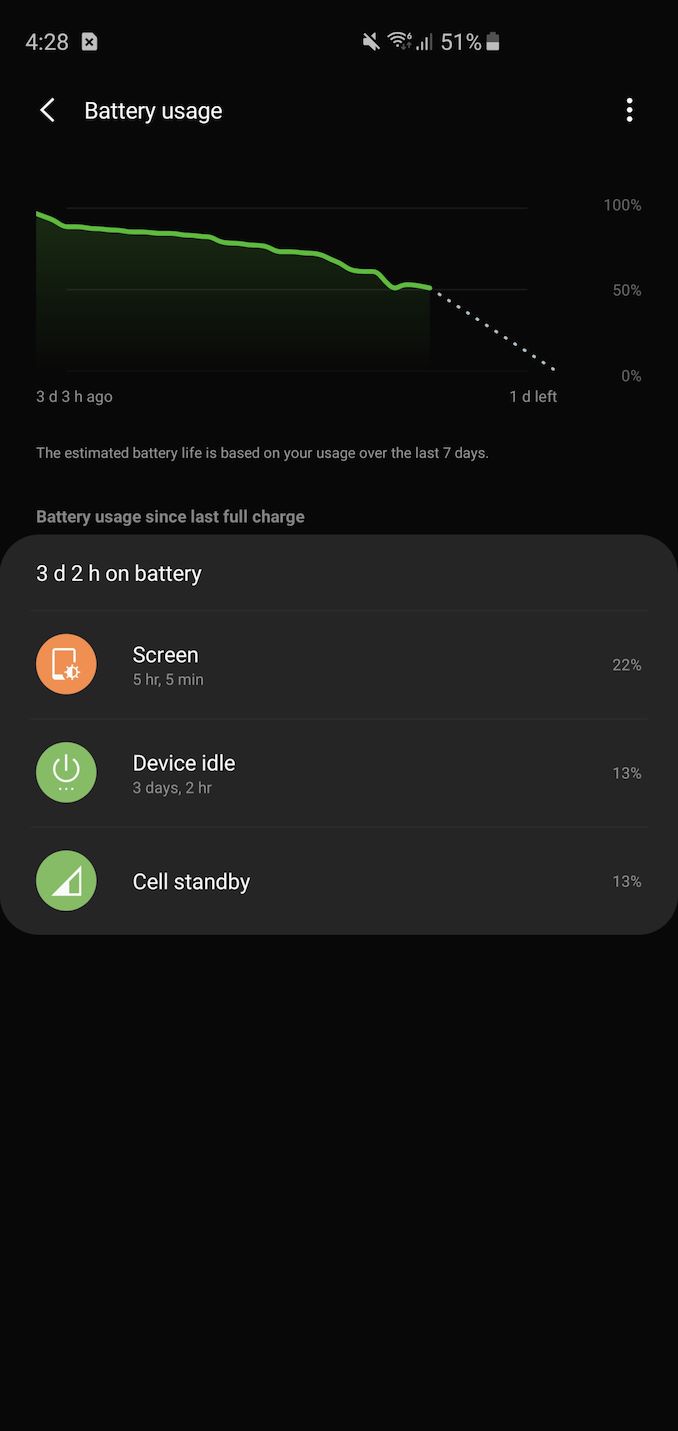The Samsung Galaxy S10+ Snapdragon & Exynos Review: Almost Perfect, Yet So Flawed
by Andrei Frumusanu on March 29, 2019 9:00 AM ESTBattery Life: Impressive
Battery performance of the Galaxy S10+ has been touted to be as class-leading. The introduction of a larger battery, more efficient screen as well as a new generation of SoCs are sure to bring improvements over last year’s Galaxy S9. One aspect that readers will have waited for impatiently is our testing of the new Exynos 9820 variant against the Snapdragon 855, which has also been one topic I’ve been extremely interested to see.
We run Samsung's Galaxy devices at the full potential they can deliver, something we've done for several generations now. This means that the screen resolution is set to the native 1440p of the display panels, and the new battery settings on the S10 were also set to "Performance" mode.
Without further ado, let’s get do the results:

In our web browsing test, both Galaxy S10+s are showcasing outstanding longevity at 13.08h for the Exynos and 12.75h for the Snapdragon variant. Least to say, I was extremely surprised to see this result even though we measured the Exynos 9820 CPU to be quite less efficient than the Snapdragon 855 in peak performance efficiency. I would have not expected the Exynos to match the Snapdragon, much less slightly beat it.
Before going into more details, let’s see the PCMark battery test results:

Here, in absolute terms, the Galaxy S10+ aren’t quite as impressive as on the web test and further lag behind the excellent results of the Kirin 980 devices. Nevertheless, these are some impressive figures and again it’s very good to see that both units are almost evenly matched, this time the Snapdragon unit lasting slightly longer than the Exynos.
To explain these results, we have to keep one thing in mind: the Exynos unit will have posted worse performance than the Snapdragon, so it will have spent more time at the lower more efficient frequency states.
One thing that I also noticed, is that in very low idle loads where there’s just some light activity on the A55 cores, the Exynos 9820 variant actually uses less power than the Snapdragon unit. The figures we’re talking about here are 20-30mW, but could possibly grow to bigger values at slightly more moderate loads. It’s possible that Qualcomm has more static leakage to deal with on the 7nm process than Samsung on 8nm, one thing that I’ve come to hear about the TSMC 7nm node.
Furthermore, one of the biggest improvements for the Galaxy S10 over past devices isn’t actually the SoC nor the actual bigger battery. It’s actually the display as well as the base power consumption of the phone. In Airplane mode, the base power has gone down by almost 100mW compared to the Galaxy S9+ which is a fantastic development and is especially something that will result in higher low-brightness battery life.
Currently in my time with both S10+ units, I can say they’ve been among the longest lasting Android devices I’ve tested.


Exynos vs Snapdragon in identical usage patterns & Prolonged idle periods
One issue I can confirm with the Exynos unit is that after a voice call in any app, the phone isn’t correctly entering its lower power state, and will suffer from increased idle battery drain until a reboot. This is something that hopefully Samsung addresses in a firmware update as it doesn’t look to be a hardware related issue. When not affected by this bug, both phones idle very similar to each other and slightly better than the S9+ I use as my daily device.










229 Comments
View All Comments
Irish910 - Saturday, March 30, 2019 - link
Where is that website link that shows how many MORE times android tracked someone over iOS over the course of a day.....id4andrei - Sunday, March 31, 2019 - link
Google is pretty transparent about what it gathers and how it is using it. You can download at anytime anything relating to your metdata. You can wipe history of that data. You can disable tracking, personalized advertising and more. These controls are available to you in Android and your google account. This is one thing. Saying that Android has ads and has inherent security issues is another and it's plain bullshit. Saying that the Google store is the wild west is also bullshit.name99 - Friday, March 29, 2019 - link
"Exynos 9820 is the first tri-CPU cluster/group SoC which actually consists of three different CPU microarchitectures"It's not exactly comparable, but the A12/A12X has (at least) three different ARMv8 cores on it, the big cores (Vortex), the small cores (Tempest) and the tiny controller cores (but still ARMv8) Chinook. There are doubtless some number of M0s and suchlike ARMv7 cores also scattered around, but it's interesting that there are three different Apple-designed cores.
It's also interesting, in terms of area, to scan
https://en.wikipedia.org/wiki/Apple-designed_proce...
Notable comparisons, for example, are A9X vs A10 (nominally both 16mm FF, but A10 uses the resources more efficiently) and A10 vs A10X.
Andrei Frumusanu - Friday, March 29, 2019 - link
Oh come on you know better than this. The Chinooks are not part of the CPU cluster and aren't userspace program visible.I'm also not counting the Cortex A5's in the Exynos' audio and ISPs or the multitude of Cortex M3s it has.
name99 - Friday, March 29, 2019 - link
Don't want to argue about it; I just thought this was an interesting point :-)I'd be just as interested if we learned that QC (or ARM proper) were using ARMv8 devices (ie "interesting" cores, not tiny cores) to handle any of their "controller" type functionality, eg controlling the NPU or GPU.
tuxRoller - Friday, March 29, 2019 - link
I've not finished the article so perhaps you address these issues elsewhere."I wish Samsung at least would mimic the haptics with the fingerprint sensor."
Coupling haptics and an ultrasonic sensor that also looks beyond surfaces seem like it would be more difficult than just measuring capacitance.
Also, since the ultrasonic sensor works when the screen is off one should expect the apparent interaction time to go up. Did you happen to time it when the screen was on? The last scenario would be timing its unlock cycle when the phone is in use (any of the password managers should be fine).
Andrei Frumusanu - Friday, March 29, 2019 - link
> Did you happen to time it when the screen was on?I didn't do high-speed camera testing of it, but it does look every so slightly faster to respond.
tuxRoller - Saturday, March 30, 2019 - link
That's not too bad then. Most of the reviews I've seen haven't mentioned the new sensor being particularly slow, so, your experience stood out to me.name99 - Friday, March 29, 2019 - link
I don't know if the iOS 12.2 update had a change to scheduler or JS that has an important effect on web scheduling, but I got 124 for Jetstream 2 on my iPhone XS which is, of course, substantially better than the 98 that Andrei sees.FWIW I got a very similar number on my iPad Pro A12X, and on my iMac Pro (Xeon W turbos to 4.2 GHz) I got 142, which is remarkably close to the A12/A12X number...
tipoo - Sunday, March 31, 2019 - link
How nuts is it that for largely ST bound tasks like Javascript, the A12 hangs right in there with the Xeon W, which turbos to 4.2GHz.Scale up the core count and memory bandwidth and I don't see why anyone would assume that wouldn't be a very competent chip even for higher end systems, if the software for ARM support was there.